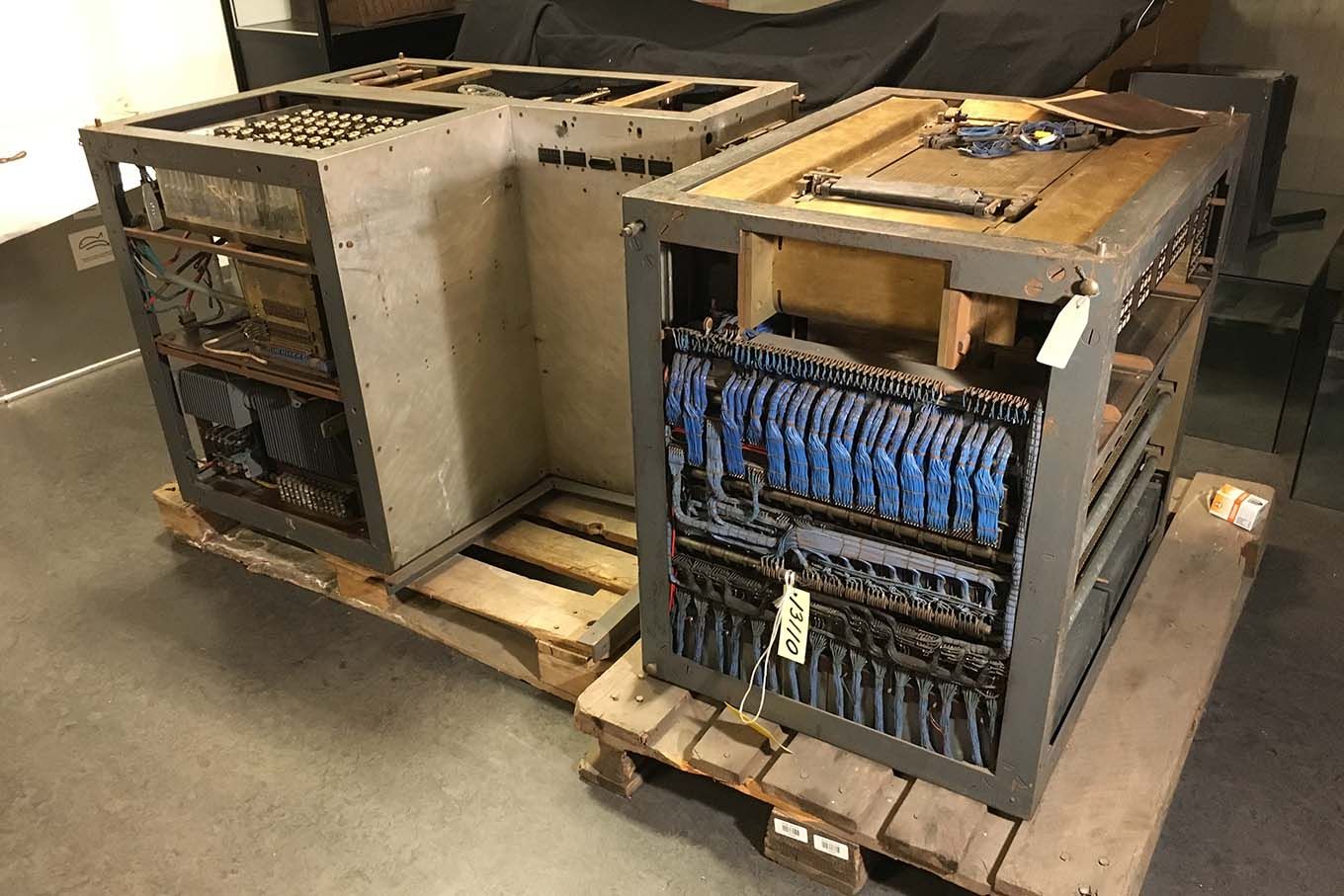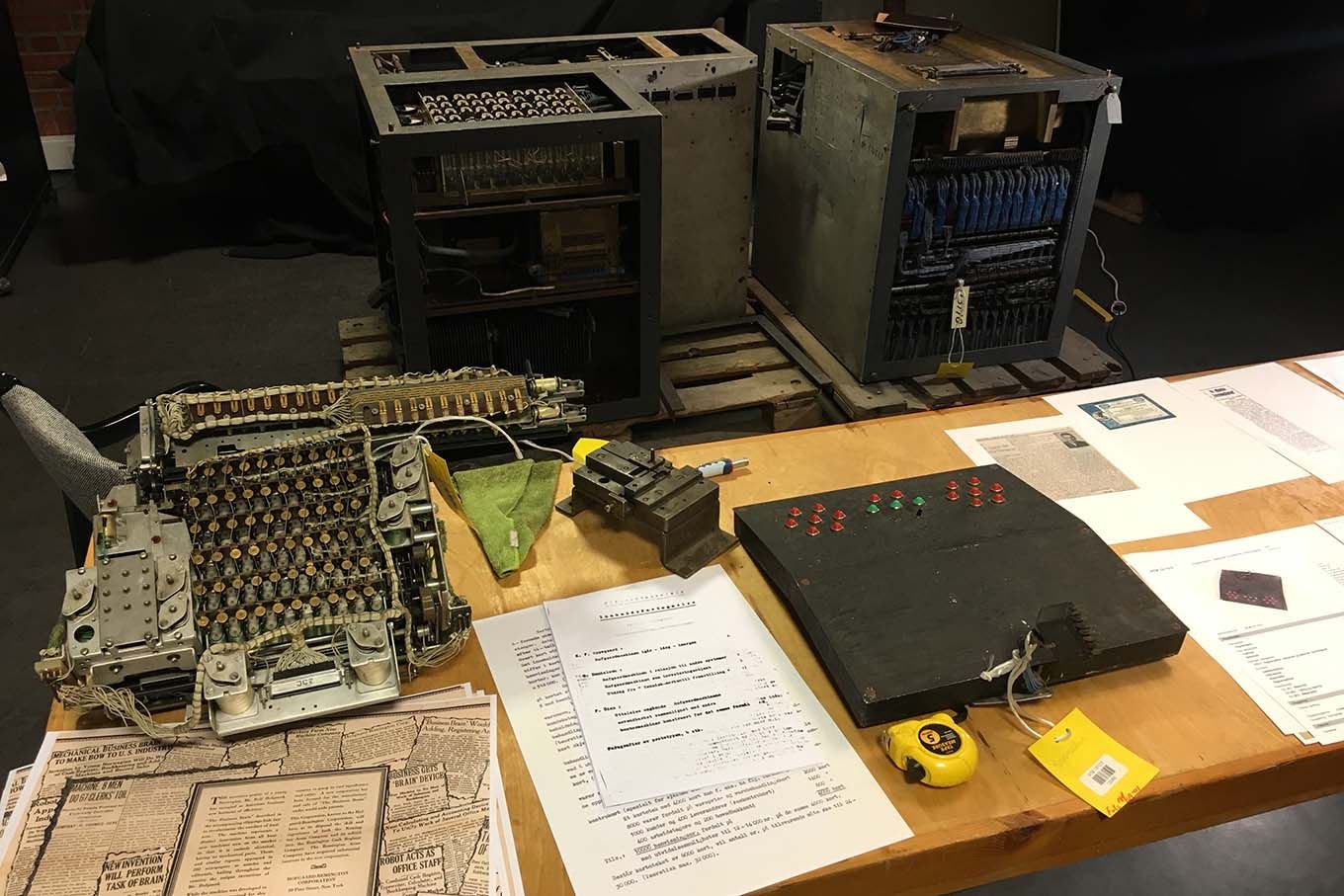
The Hofgaard machine. Photo: The Norwegian Museum of Science and Technology
The Hofgaard machine
An early Norwegian computer?
By Dag K. Andreassen , Conservator at The Norwegian Museum of Science and Technology and research fellow at the Department of Historical and Classical Studies, NTNU
The research project on the Hofgaard machine is based on an object in The Norwegian Museum of Science and Technology 's collection that is little known, barely researched, and has never been exhibited. It is a prototype from 1955 of an office machine with functions such as accounting, invoicing, databases and stock management, based on a number of patents that the Norwegian Rolf Hofgaard took out in the period 1924-1955.
For the first half of the period, Hofgaard was in the USA in partnership with the office machine giant Remington. In the second half of the period, when this prototype was developed, he was in Oslo, engaged by the electrical company Sønnico, which bet on Hofgaard and his ideas about office automation. The system integrated advanced mathematical models and coding with complex fine mechanics and relay-based electromechanics. It was intended as a mass-produced industrial product. The prototype was demonstrated and recognized for its potential, but was never funded into a finished commercial product.
What can we learn from the Hofgaard machine?
Rolf Hofgaard took out and maintained a number of patents on electromechanical calculators from 1924 to the mid-1950s. A prototype from 1956 for an electronic office machine with file index, calculator, input and printing units belongs to The Norwegian Museum of Science and Technology 's collection.
In the latter half of the 1920s, Hofgaard was in the most central office technology development environments in the United States. He established, among other things, a large development laboratory in partnership with Remington. From the mid-1930s to 1960, Hofgaard worked in Norway, eventually in collaboration with the electrical company Sønnico. The machine was demonstrated in the mid-1950s, but never put into production. The prototype was given to The Norwegian Museum of Science and Technology , but has never been exhibited.
What can such a machine and such a development project teach us about technological development, or more specifically about the genesis of computers?
Overtaken by digital electronic computers
By the end of the 1950s, Hofgaard's solutions were parked and overtaken by the digital electronic computers that found their basic design during the first decade after the Second World War.
From research environments in the USA and Great Britain, primarily funded by the needs of war technology, industrial solutions sprung up aimed at military and civilian markets. The Norwegian electronics community after the war had strong connections to the Anglo-American communities., first through contacts established through the dozens of Norwegian engineers and scientists who were in exile in Great Britain during the war, and who gained entry into the most central British electronics research communities.
In the post-war years, study trips and stays at various American environments were mandatory for those who led the way in machine building in Norway in the 1950s. Jens Glad Balchen at NTH is said to have found inspiration from studying at Yale University in 1951 for his electronic analogue machine DIANA. In the same way, Thomas Hysing, who led the work on Norway's first electronic digital machine NUSSE at SI in Oslo, had studied relay engineering at UCLA Berkley before he started the machine construction in Oslo in 1951.
The next generation of NTH engineers who formed the core of the numerical group at FFI, many of whom would break out and start what became Norsk Data, were in turn on longer study stays at MIT. These well-known stories give an overall impression that the connections between the US and Norwegian development circles around electronic calculators are a purely post-war phenomenon. The story of Rolf Hofgaard and his machine can modify this.
"Year zero" should not be defined if we want to understand connections
Norwegian and international computer history has a heavy emphasis on the development after 1945. Computer historical research has thus largely concentrated on the history after 1945, with an emphasis on wartime projects and the introduction of the radio tube as decisive.
Norwegian research follows the same line. The picture is dominated by the research institutions' interest in computing power, and gradually a state-sponsored interest in the acquisition and use of electronic calculators also in industry and administration. Accounts of environments and people involved in the development of a Norwegian computer industry start in 1945.
In this tradition, the American ENIAC is the progenitor – the first generation – and today's diversified machine fleet are all, in a way, ENIAC's descendants. In such a genealogy there is a danger of defining a "year zero" which weakens the image of important backgrounds, transitions and overlaps between technologists.
Forward from oblivion
One specific story is most often absent: Rolf Hofgaard's work with his data processing system aimed at the private business world, developed in collaboration with the leading American office machine companies in the 1920s, and in collaboration with Norwegian investors in the 1930s to 50s.
Hofgaard is most active in a transition between the first mechanical calculators and punched card systems that Hollerith and Bull represent in Norway, and the post-war "zero point" with electronics and radio tubes. Although he was also active in Norway in the post-war period, in the same period as the Norwegian electronics pioneers, he is not mentioned in the literature. This may be because the Hofgaard machine is an example of a failed innovation. It stands out with equal narrative power about a transitional technology and a development project that was not a small-scale rarity, lonely in a secluded garage.
On the contrary, Hofgaard is among the first to make the journey from Norway to the USA to make his contribution to bringing the office machine industry into the age of electronics. He establishes cooperation with one of the leading companies in the industry, Remington, which goes into partnership with Hofgaard and sets up a large development lab in Bridgeport CN.
The crash of 1929 and the unrest that followed put an end to the company Hofgaard-Remington Corporation, and the estate was sold to the National Cash Register (NCR). According to Hofgaard, a hundred patents came with the purchase.
Does this mean that Hofgaard's development work also left its mark on the post-war machine park, as it was developed by companies such as Remington, NCR and IBM? It is among the questions to be investigated.
The most important thing is that the research project will shed new light on one of the museum's objects, simply by asking "What kind of machine is this?", and then putting all findings into the great computer historical narrative, which, like most other things in technology - and the history of innovation is rarely about the ingenious inventions and clear breakthroughs of individuals, but about the many thousands of small and large attempts, missteps, breakthroughs and path choices on the way to our modern information society.








